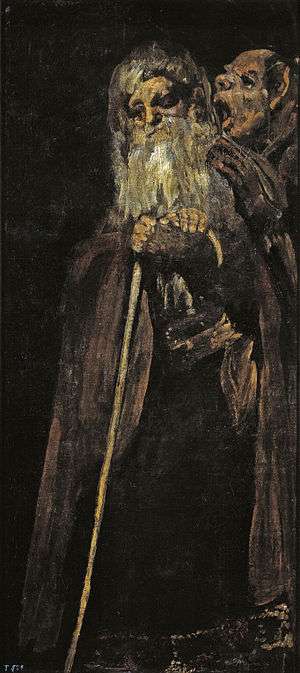Two Old Men
Two Old Men, also known as Two Monks or An Old Man and a Monk (Spanish: Dos viejos, Dos frailes, or Un viejo y un fraile), are names given to one of the 14 Black Paintings painted by Francisco Goya between 1819-23.[1][2][3][4] At the time Goya was in his mid-seventies and was undergoing a great amount of physical and mental stress after two bouts of an unidentified illness. The works were rendered directly onto the interior walls of the house known as Quinta del Sordo ("The House of the Deaf Man").[5] that he purchased in 1819.
| Two Old Men / Two Monks / An Old Man and a Monk | |
|---|---|
| Spanish: Dos viejos / Dos frailes / Un viejo y un fraile | |
 | |
| Artist | Francisco Goya |
| Year | 1819-1823 |
| Medium | Oil mural transferred to canvas |
| Dimensions | 146 cm × 66 cm (57 in × 26 in) |
| Location | Museo del Prado, Madrid |
Footnotes
- Dowling, John (1973). "Buero Vallejo's Interpretation of Goya's 'Black Paintings'". Hispania. 56 (2): 449–457. doi:10.2307/339706. JSTOR 339706.
- Hughes, Robert (2004). Goya. London: Vantage. p. 32.
- Hagen, Rose-Marie, Hagen, Rainer (2003) Francisco Goya, 1746-1828, Taschen, Koln. p. 74.
- The Pinturas Negras (Black Paintings) in alphabetic order; A Pilgrimage to San Isidro, Atropos (The Fates), Fantastic Vision, Fight with Cudgels, Judith and Holofernes, La Leocadia. Men Reading, Procession of the Holy Office, Saturn Devouring His Son, The Dog, Two Old Men, Two Old Men Eating Soup, Witches' Sabbath, Women Laughing,
- Glendinning, Nigel, (1975) "The Strange Translation of Goya's Black Paintings", The Burlington Magazine, CXVII, 868: 446.
- Havard, Robert (2007) The Spanish Eye: Painters and Poets of Spain, Woodbridge, Tamesis, p. 60.
- Petra ten-Doesschate Chu, Laurinda S. Dixon, “Goya’s ambiguous Saturn” in Twenty-first-century Perspectives on Nineteenth-century Art: Essays in Honor of Gabriel P. Weisberg, University of Delaware Press; Newark, 2008, p. 127.
- Licht, Fred (1983). Goya: the origins of the modern temper in art. New York: Harper and Row. p. 168.
- Felisati, D.; Sperati, G. (5 October 2010). "Francisco Goya and his illness". Acta Otorhinolaryngologica Italica. 30 (5): 264–270. PMC 3040580. PMID 21804693.
- Hagen, Rose-Marie, Hagen, Rainer, (2003) Francisco Goya, 1746-1828, TASCHEN, Koln, p. 74.
- Licht F. (1983) Goya: the origins of the modern temper in art. New York: Harper and Row, p.160.
- Brown, Jonathan, and Mann. Richard G. (1990) Spanish Paintings of the Fifteenth through Nineteenth Centuries. The Collections of the National Gallery of Art Systematic Catalogue. Washington, D.C. p. 3.
- Licht, Fred. (1979) Goya: The Origins of the Modern Temper in Art. Universe Books, p. 159.
- Glendinning, Nigel, (1975) "The Strange Translation of Goya's Black Paintings", The Burlington Magazine, CXVII, 868: 466.
- Hughes, p. 16,17.
- Glendinning, Nigel, (1975) "The Strange Translation of Goya's Black Paintings", The Burlington Magazine, CXVII, 868: 474.
Bibliography
- Benito Oterino, Agustín, La luz en la quinta del sordo: estudio de las formas y cotidianidad, Madrid, Universidad Complutense, 2002, p. 33. Edición digital ISBN 84-669-1890-6.
- Bozal, Valeriano, Francisco Goya, vida y obra, (2 vols.) Madrid, Tf. Editores, 2005. ISBN 84-96209-39-3.
- Bozal, Valeriano, Pinturas Negras de Goya, Tf. Editores, Madrid, 1997.
- Brown, Jonathan, and Mann. Richard G. (1990) Spanish Paintings of the Fifteenth through Nineteenth Centuries. The Collections of the National Gallery of Art Systematic Catalogue. Washington, D.C.
- Dowling, John (1973). "Buero Vallejo's Interpretation of Goya's 'Black Paintings'". Hispania. 56 (2): 449–457. doi:10.2307/339706. JSTOR 339706.
- Felisati, D.; Sperati, G. (5 October 2010). "Francisco Goya and his illness". Acta Otorhinolaryngologica Italica. 30 (5): 264–270. PMC 3040580. PMID 21804693.
- Glendinning, Nigel, Francisco de Goya, Madrid, Cuadernos de Historia 16 (col. «El arte y sus creadores», nº 30), 1993.
- Glendinning, Nigel, "The Strange Translation of Goya's Black Paintings", The Burlington Magazine, CXVII, 868, 1975. 446.
- Hagen, Rose-Marie and Hagen, Rainer, Francisco de Goya, Cologne, Taschen, 2003. ISBN 3-8228-2296-5.
- Hughes, Robert. Goya. New York: Alfred A. Knopf, 2004. ISBN 0-394-58028-1
- Licht, Fred. Goya: The Origins of the Modern Temper in Art. (Universe Books, 1979).
- Petra ten-Doesschate Chu, Laurinda S. Dixon, “Goya’s ambiguous Saturn” in Twenty-first-century Perspectives on Nineteenth-century Art: Essays in Honor of Gabriel P. Weisberg, (University of Delaware Press; Newark, 2008).
- Robert Havard, The Spanish Eye: Painters and Poets of Spain, (Woodbridge, Tamesis, 2007).
This article is issued from Wikipedia. The text is licensed under Creative Commons - Attribution - Sharealike. Additional terms may apply for the media files.